Scottish Local Government Finance Statistics (SLGFS) 2018-19
Annual publication providing a comprehensive overview of financial activity of Scottish local authorities in 2018-19 based on authorities' audited accounts.
This document is part of a collection
2. Revenue Expenditure and Income
Revenue expenditure is the cost of delivering services each year and includes both service operating costs and overheads. These costs might include salaries, rent, building maintenance, supplies and services. The benefits from revenue expenditure are mainly received within the financial year.
Revenue expenditure also includes costs that cannot be directly attributed to a service, such as the repayment of debt and where a local authority has used revenue resources to fund capital investment.
All authorities are required to have a General Fund which is used to account for all revenue activity, except that relating to local authority housing. The General Fund is the principle revenue reserve of the local authority.
Where a local authority has housing, it is required to have a Housing Revenue Account (HRA) which records expenditure and income relating to their direct provision of housing. HRAs are generally self-financing, that is the income received is sufficient to cover expenditure incurred. Of the 32 councils, 26 have an HRA.
The Orkney County Council Act 1974 and the Zetland County Council Act 1974 require Orkney and Shetland to also hold a Harbour Account, a separate account and reserve fund specifically for harbour undertakings. Orkney and Shetland are also able to transfer money between their General Fund and their Harbour Accounts. For the purposes of this chapter, expenditure and income relating to Harbour Accounts is included in General Fund figures.
Revenue expenditure is principally funded through service income (Chapter 2.1.4) and general funding, which consists of grants from government and income from taxation (Chapter 2.3). Any deficit (+) in a local authorities’ revenue accounts is met from their reserves, and any surplus (-) is added to a local authorities’ reserves and carried forward to the next year (Chapter 2.4).
Table 2.1 summarises revenue expenditure, income and reserves in 2018-19. More details on each section of this table are provided in the remainder of this chapter.
Table 2.1: Revenue Expenditure, Income and Reserves in 2018-19, £ millions
| Expenditure and Income on Services | General Fund1 | Housing Revenue Account | Total |
|---|---|---|---|
| Gross Service Expenditure | 15,611 | 709 | 16,320 |
| Gross Service Income | -4,839 | -1,230 | -6,070 |
| Net Revenue Expenditure on Services | 10,771 | -521 | 10,250 |
| Other Expenditure and Income | 1,172 | 540 | 1,713 |
| Total Revenue Expenditure | 11,944 | 19 | 11,963 |
| General Funding | |||
| General Revenue Grant | -6,885 | 0 | -6,885 |
| Non-Domestic Rates | -2,636 | 0 | -2,636 |
| Council Tax | -2,376 | 0 | -2,376 |
| Other | -13 | 0 | -13 |
| Total General Funding | -11,910 | 0 | -11,910 |
| Surplus (-) or Deficit (+) to be met from Reserves | 33 | 19 | 53 |
Source: LFR A0, LFR 00
Notes
1 Amounts relating to Harbour Accounts for Orkney and Shetland are included in the General Fund column of this table.
2.1 Expenditure and Income on Services
Net Revenue Expenditure, also known as the net cost of services, is the element of service expenditure that is funded by general funding or reserves. It is calculated as gross service expenditure minus gross service income. As shown in Table 2.1, the net revenue expenditure on local authority services, including HRA, in 2018-19 was £10,250 million, an increase of 1.6 per cent from £10,088 million in 2017-18.
2.1.1 Net Revenue Expenditure by Service
Chart 2.1 shows net revenue expenditure on services in Scotland in 2018-19. Education has the highest net revenue expenditure at £5,057 million followed by Social Work which has a net revenue expenditure of £3,247 million.
Both Trading Services and the Housing Revenue Account had a negative net revenue expenditure in 2018-19 at -£35 million and -£521 million respectively. This means that their gross service expenditure was less than their gross service income in 2018-19.
Chart 2.1: Net Revenue Expenditure in 2018-19 by Service, £ millions
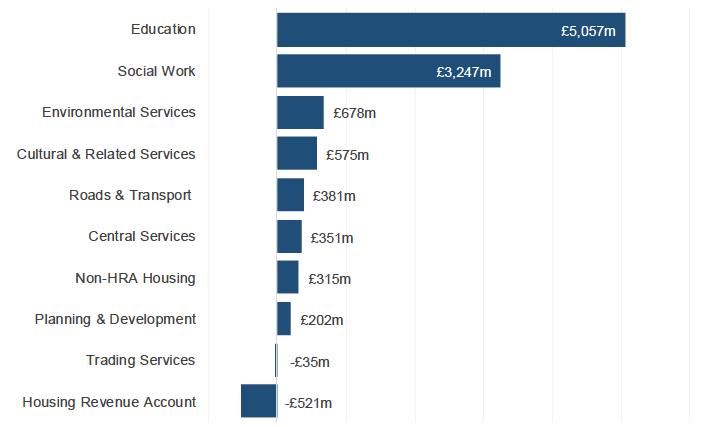
Source: LFR 00
Table 2.2 shows how net revenue expenditure by service has changed between 2014-15 and 2018-19. Education, Culture and Related Services, Social Work, Trading Services and the HRA have all shown increases in net revenue expenditure between 2017-18 and 2018-19. Net revenue expenditure for the remaining five services has decreased on 2017-18.
Net revenue expenditure on Education has increased by 4.4 per cent in 2018-19. This continues the trend seen in prior years, with Education the only service area to have shown increases in expenditure in each year since 2014-15, with an overall increase of ten per cent over this five year period.
Culture and Related Services saw an increase of 2.6 per cent in net revenue expenditure in 2018-19. This is the first increase in this service between 2014-15 and 2018-19, with all prior years showing small decreases.
Net revenue expenditure on Social Work increased by 3.8 per cent in 2018-19, having remained broadly stable between 2014-15 and 2017-18. As set out in Chapter 1, 30 IJBs have been established to facilitate the integration of health and social care services in conjunction with local authorities and health boards. If local authorities contribute more to IJBs than they receive, the net contribution is included as expenditure incurred by the local authorities. If local authorities contribute less to IJBs than they receive, the net contribution is included as income received by the local authorities.
Roads & Transport has seen a decrease in net revenue expenditure by 11.8 per cent from £432 million to £381 million in 2018-19. This service area has fluctuated over the five year period shown in Table 2.2. Some of this variation will relate to weather conditions in each particular year, with worse weather requiring increased expenditure on maintenance in year.
Net revenue expenditure on Central Services has decreased by 21.7 per cent, from £449 million in 2017-18 to £351 million in 2018-19. This decrease is likely due to a number of factors as Central Services covers a range of subservices. For example, expenditure on conducting elections and Housing Benefit administration would reasonably be expected to be less in 2018-19. This service is also where local authorities can record any expenditure which does not relate to any other services, such as costs incurred relating to equal pay for previous years, and so this amount can fluctuate between years.
Both the HRA and Trading Services have negative net revenue expenditure. This means they incur less service expenditure than they receive in service income and so local authorities’ overall received income from these services. In both cases, the income local authorities are receiving has increased steadily over the last five years.
Table 2.2: Net Revenue Expenditure from 2014-15 to 2018-19 by Service, £ millions 1
| 2014-15 | 2015-16 | 2016-17 | 2017-18 | 2018-19 | % change between 2017-18 & 2018-19 | |
|---|---|---|---|---|---|---|
| Education | 4,612 | 4,736 | 4,830 | 4,841 | 5,057 | 4.4% |
| Culture & Related Services | 643 | 598 | 577 | 561 | 575 | 2.6% |
| Social Work | 3,110 | 3,169 | 3,136 | 3,129 | 3,247 | 3.8% |
| Roads & Transport 2 | 420 | 422 | 399 | 432 | 381 | -11.8% |
| Environmental Services | 666 | 684 | 679 | 688 | 678 | -1.5% |
| Planning and Development | 278 | 243 | 234 | 213 | 202 | -5.2% |
| Central Services | 439 | 465 | 390 | 449 | 351 | -21.7% |
| Non-HRA Housing | 342 | 294 | 292 | 317 | 315 | -0.5% |
| Trading Services | -5 | -17 | -27 | -30 | -35 | 14.4% |
| General Fund Net Revenue Expenditure | 10,504 | 10,595 | 10,511 | 10,600 | 10,771 | 1.6% |
| Housing Revenue Account | -465 | -490 | -499 | -511 | -521 | 1.9% |
| Total GF & HRA Net Revenue Expenditure | 10,039 | 10,105 | 10,012 | 10,088 | 10,250 | 1.6% |
Source: LFR 00
Notes
1 Amounts relating to Harbour Accounts for Orkney and Shetland are included in the General Fund figures in this table.
2 Including Road Bridges.
2.1.2 Net Revenue Expenditure by Local Authority
Chart 2.2 shows net revenue expenditure on services, excluding the HRA, per person by council. VJBs, RTPs and Tay Road Bridge have been excluded from this analysis.
Chart 2.2: General Fund Net Revenue Expenditure in 2018-19 by Council, £ per person
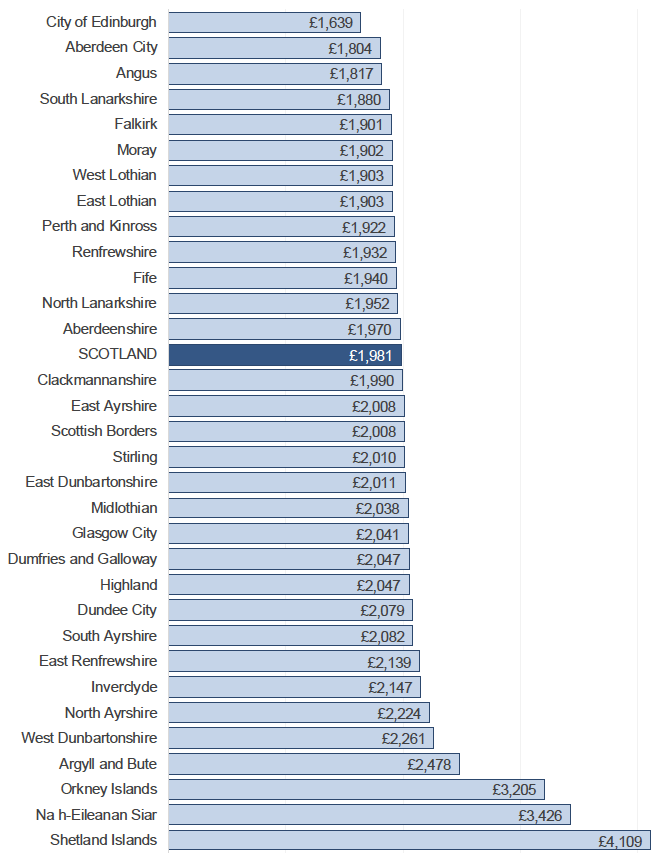
Source: LFR 00, Mid-Year Population Estimates
On average, councils’ in Scotland spent £1,981 per person in 2018-19, an increase from £1,954 in 2017-18. Spend ranged from £1,639 per person in Edinburgh to £4,109 per person in Shetland.
2.1.3 Gross Service Expenditure
Gross Service Expenditure is the total expenditure on local authority services within a financial year, minus any intra / inter-authority transfers. Gross Service Expenditure was £16,320 million in 2018-19, an increase of 2.8 per cent from £15,870 in 2017-18. Table 2.3 shows gross service expenditure by type of expenditure from 2014-15 to 2018-19.
Table 2.3: Gross Service Expenditure from 2014-15 to 2018-19 by Expenditure Type, £ millions
| 2014-15 | 2015-16 | 2016-17 | 2017-18 | 2018-19 | % change between 2017-18 & 2018-19 | |
|---|---|---|---|---|---|---|
| Employee Costs | 6,213 | 6,283 | 6,713 | 6,864 | 7,196 | 4.8% |
| Operating Costs | 6,731 | 6,721 | 6,828 | 7,090 | 7,456 | 5.2% |
| Transfer Payments | 2,107 | 2,077 | 2,218 | 2,178 | 2,199 | 1.0% |
| Support Services | 845 | 867 | 824 | 743 | 746 | 0.5% |
| Adjustment for Intra / Inter Authority Transfers | -671 | -617 | -994 | -1,005 | -1,277 | 27.1% |
| Gross Service Expenditure | 15,224 | 15,331 | 15,590 | 15,870 | 16,320 | 2.8% |
Source: LFR 00
Operating costs are the largest element of gross service expenditure, accounting for £7,456 million, an increase of 5.2 per cent from £7,090 in 2017-18. This expenditure includes property costs, supplies and services costs, transport and plan costs, payments to agencies and other bodies and direct administration costs.
The second largest element is employee costs, which accounts for £7,196 million of gross service expenditure, an increase of 4.8 per cent from £6,864 in 2017-18. These costs relate to salaries and wages, national insurance and superannuation contributions, cash allowances paid to employees, redundancy and severance payments and any other costs relating to employees.
Transfer payments make up £2,199 million of gross service expenditure which has increased by 1.0 per cent from £2,178 in 2017-18. This expenditure relates to payments made to individuals for which no goods or services are received in return by the local authority, such as paying Housing Benefits or Social Work Direct Payments. This figure also includes any net contributions made to IJBs, that is where the local authority contributes more money to their IJB than they receive.
Support services costs are the smallest component of gross service expenditure, accounting for only £746 million. This is consistent with expenditure on support services in 2017-18 which accounted for £743 million. These are costs that are paid for services that support the provision of services to the public, such as IT, Human Resources, Legal services, Procurement services and Corporate services.
An adjustment for intra / inter-authority transfers of -£1,277 million has been made to the aggregate gross service expenditure figure. This is to prevent double counting of expenditure caused by transfers between different services within an authority and between local authorities. The adjustment removes the total recharge income from other services, contributions from other local authorities and requisition income. Following the adjustment, expenditure is only reported against the authority or service area that commissioned the service.
Gross service expenditure has increased by 7.2 per cent over the last five years. This has largely been driven by increases in employee and operating costs, which have increased by 15.8 and 10.8 per cent respectively since 2014-15. The adjustment for intra / inter-authority transfers has also increased over this period, almost doubling from -£671 million in 2014-15 to -£1,277 million in 2018-19.
Chart 2.3 shows the breakdown of gross service expenditure by service and by expenditure type. Education has a higher proportion of employee costs than other services – this is due to the higher number of staff employed within Education, in particular teachers. Non-HRA Housing has a significantly higher proportion of transfer payments than other services which relates to the payment of Housing Benefits. Other, including Central Services, has the largest adjustment for intra / inter authority transfers which is due to Central Services and Trading Services having particularly high amounts of recharge income from other services.
Chart 2.3: Gross Service Expenditure in 2018-19 by Service and Expenditure Type, £ millions
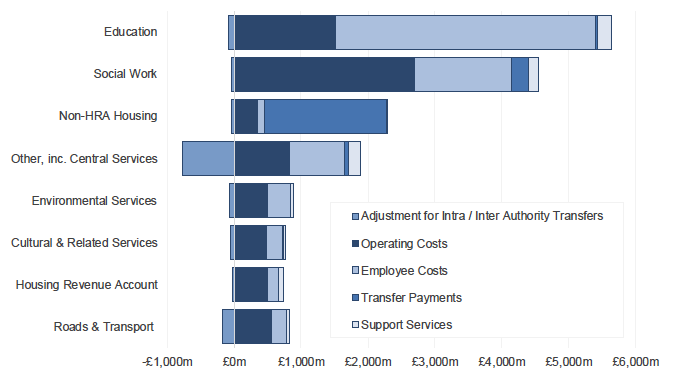
Source: LFR 00
2.1.4 Service Income
Gross Service Income is the total income a local authority receives for services. In 2018-19, local authorities received £6,070 million in service income, a 5.0 per cent increase from £5,782 million in 2017-18.
Local authorities receive service income from a variety of sources. Table 2.4 shows gross service income by type of income from 2014-15 to 2018-19.
Table 2.4: Gross Service Income from 2014-15 to 2018-19 by Income Type, £ millions
| 2014-15 | 2015-16 | 2016-17 | 2017-18 | 2018-19 | % change between 2017-18 & 2018-19 | |
|---|---|---|---|---|---|---|
| Government Grants (excluding GRG) | -1,984 | -2,036 | -2,138 | -2,206 | -2,380 | 7.9% |
| Other Grants, Reimbursements and Contributions | -833 | -768 | -902 | -1,040 | -1,092 | 5.1% |
| Customer and Client Receipts 1, 2 | -2,368 | -2,423 | -2,537 | -2,537 | -2,597 | 2.4% |
| Gross Service Income | -5,185 | -5,226 | -5,577 | -5,782 | -6,070 | 5.0% |
Source: LFR 00
Notes
1 This includes credits resulting from soft loans.
2 Customer and Client Receipts from 2014-15 to 2018-19 broken down by service are available in Table 2.4a in the associated Excel file.
Customer and client receipts is income local authorities have received for sales, rents, fees and charges as a result of the services they provide. This was local authorities’ largest source of service income in 2018-19, accounting for £2,597 million, an increase of 2.4 per cent from 2017-18. Customer and client receipts have increased steadily between 2014-15 and 2018-19, with an overall increase of 9.7 per cent over this period.
The second largest source of service income is government grants, excluding General Revenue Grant (GRG), which accounts for £2,380 million, an increase of 7.9 per cent from 2017-18. Unlike the GRG, these government grants are provided to support a specific service and include grant from DWP to be used to pay out Housing Benefit and Ring-Fenced Revenue Grants (RFRG) paid out by Scottish Government. In 2018-19, authorities received money in relation to five RFRGs:
- Gaelic
- Pupil Equity Fund
- Early Years Expansion
- Criminal Justice Social Work
- Support for Ferries
These service specific government grants have increased by 20.0 per cent between 2014-15 and 2018-19, with this increase evenly spread over this period.
The remainder of local authorities’ service income is made up of other grants, reimbursements and contributions, which accounted for £1,092 million of service income in 2018-19, an increase of 5.1 per cent from 2017-18. This type of service income has increased by 31.2 per cent between 2014-15 and 2018-19, however most of this increase took place between 2015-16 and 2017-18.
Chart 2.4 shows the breakdown of gross service income by service and income type. Non-HRA Housing received the most service income, the vast majority of which is grant from DWP to fund the payment of Housing Benefit. Education also received a large proportion of service income from Education specific government grants, in particular three of the five RFRGs that local authorities received in 2018-19.
Social Work has a high proportion of service income from other grants, reimbursements and contributions and these largely relate to contributions from Health Authorities and IJBs.
Service income for the HRA is almost entirely made up of customer and client receipts which will relate to rent payments received for local authority housing.
Chart 2.4: Gross Service Income in 2018-19 by Service and Income Type, £ millions
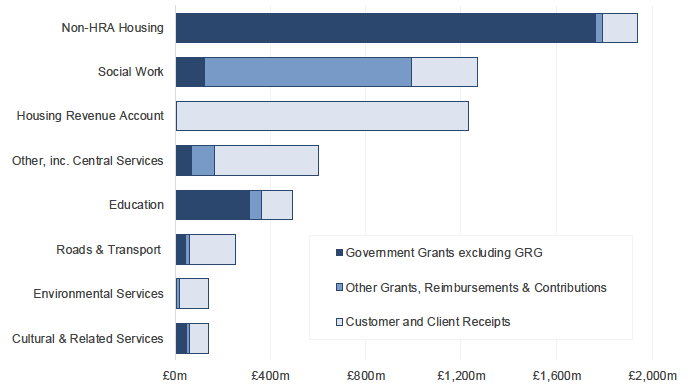
Source: LFR 00
In 2018-19, 37.2 per cent of service expenditure was met by service income. Chart 2.5 shows the proportion of service expenditure met by service income for each service. This varies significantly between services as they each receive different levels of grants and contributions, and services have differing abilities to generate service income in the form of customer and client receipts.
Service income exceeded service expenditure for the HRA and Trading Services, generating a surplus for both services.
Service income was less than service expenditure for all other services, with the amount of service expenditure being funded by service income ranging from 8.9 per cent for Education to 86.0 per cent for Non-HRA Housing.
Chart 2.5: Service Expenditure met by Service Income in 2018-19 by Service, £ millions
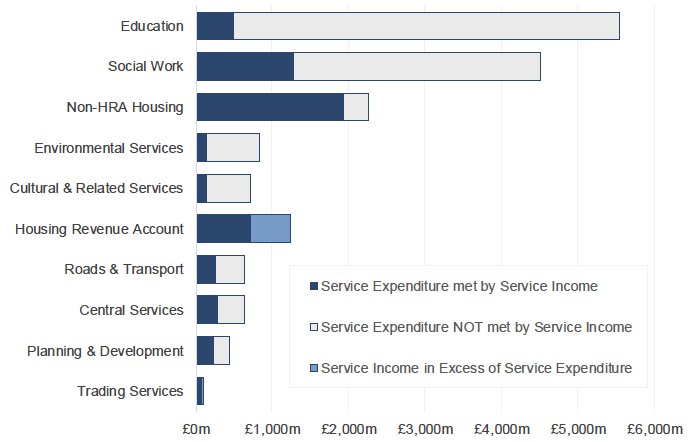
Source: LFR 00
2.2 Other Expenditure and Income
Local authorities will also incur some revenue expenditure and income that is not attributable to specific services, such as interest paid or received, statutory repayment of debts, contributions to capital expenditure, proceeds of trading operations and any other operating expenditure.
In 2018-19, local authorities incurred £1,713 million of other expenditure and income. Table 2.5 provides a breakdown of this figure, split by the General Fund and HRA. Interest paid and repayment of debts made up the majority of other expenditure, accounting for £842 million and £658 million respectively. In 2018-19, there was an overall surplus from trading operations, providing income of £7 million.
Table 2.5: Other Expenditure and Income in 2018-19, £ millions
| General Fund | Housing Revenue Account | Total | |
|---|---|---|---|
| Interest Payable and Similar Charges | 698 | 144 | 842 |
| Interest Receivable and Similar Income 1 | -90 | 4 | -86 |
| Statutory Repayment of Debt | 524 | 134 | 658 |
| Capital Expenditure Funded from Revenue | 47 | 258 | 304 |
| Surplus (-) or Deficit (+) from Trading Operations | -7 | 0 | -7 |
| Other Operating Expenditure | 1 | 2 | 2 |
| Total Other Expenditure and Income | 1,172 | 540 | 1,713 |
Source: LFR A0
Notes
1 This includes losses arising from derecognition of financial assets and recognition of credit losses on financial assets.
2.3 General Funding
General funding principally consists of the General Revenue Grant (GRG) and local taxation, specifically Non-Domestic Rates (NDR) and Council Tax. Within local authorities’ accounts, this income is referred to as ‘taxation and non-specific grant income’. Total general funding available to authorities in 2018-19 was £11,910 million, an increase of 1.4 per cent from £11,751 million in 2017-18. Chart 2.6 shows the total general funding available to local authorities in 2018-19 by type of funding.
Chart 2.6: General Funding in 2018-19 by Source, £ millions
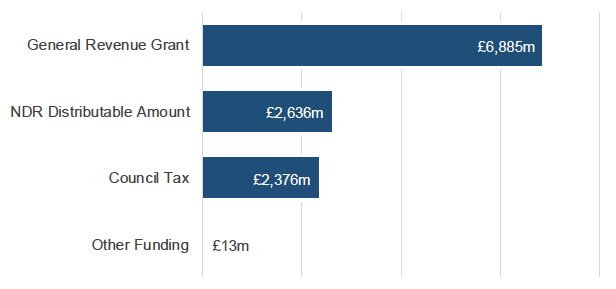
Source: LFR A0
GRG is grant paid to local authorities by the Scottish Government[1] and includes monies from the UK Government payable to a local authority. This is the main source of funding for local authorities, accounting for £6,885 million, or 57.8 per cent, of general funding in 2018-19.
Table 2.6 shows the breakdown of general funding figures between 2014-15 and 2018-19. The GRG has increased by 1.3 per cent in 2018-19, following a decrease of 4.3 per cent in 2016-17 and a decrease of 0.6 per cent in 2017-18.
NDR and Council Tax make up £2,636 million, 22.1 per cent, and £2,376 million, 20.0 per cent, of general funding respectively. More information on Council Tax and NDR is provided in Chapters 2.3.1 and 2.3.2.
Table 2.6: General Funding from 2014-15 to 2018-19, £ millions
| 2014-15 | 2015-16 | 2016-17 | 2017-18 | 2018-19 | % change between 2017-18 & 2018-19 | |
|---|---|---|---|---|---|---|
| General Revenue Grant | -7,167 | -7,147 | -6,839 | -6,799 | -6,885 | 1.3% |
| NDR Distributable Amount | -2,650 | -2,789 | -2,769 | -2,666 | -2,636 | -1.1% |
| Council Tax | -2,022 | -2,055 | -2,091 | -2,278 | -2,376 | 4.3% |
| Other Funding 1 | -85 | -13 | -9 | -9 | -13 | 55.6% |
| Total General Funding | -11,923 | -12,003 | -11,708 | -11,751 | -11,910 | 1.4% |
Source: LFR A0, LFR 00 for 2014-15
Notes
1 This includes government grants paid to joint boards and income received through NDR TIF and BRIS schemes.
2.3.1 Council Tax
Council Tax was introduced in Scotland on the 1 April 1993 to replace the Community Charge. It is a tax system based on dwellings and is a component of general funding for local authorities.
There are three factors that determine the amount of Council Tax that a dwelling is liable for:
1. The market value of the dwelling as at the 1 April 1991. Each dwelling is placed into one of eight bands from A to H, with Band A dwellings liable for the lowest rates of Council Tax and Band H attracting the highest.
2. The Band D rate which is set by the local authority, with other bands calculated as a ratio to Band D. The ratios determining the charges for properties in bands E to H were revised in 2017-18.
3. A range of exemptions, discounts and reductions that are available in certain circumstances, or in some cases an increase in Council Tax due to the application of a levy.
The valuation range and ratio for each Council Tax band is given in Table 2.7.
Table 2.7: Valuation Range and Ratios by Council Tax Band
| Valuation Band Ranges as at 1 April 1991 | Ratio to Band D 1 | No. of Chargeable Dwellings as at September 2018 | Proportion of Chargeable Dwellings | |
|---|---|---|---|---|
| Band A | Under £27,000 | 6/9 | 503,209 | 20% |
| Band B | £27,001 to £35,000 | 7/9 | 572,175 | 23% |
| Band C | £35,001 to £45,000 | 8/9 | 401,847 | 16% |
| Band D | £45,001 to £58,000 | 9/9 | 336,392 | 14% |
| Band E | £58,001 to £80,000 | 473/360 | 337,232 | 14% |
| Band F | £80,001 to £106,000 | 585/360 | 196,377 | 8% |
| Band G | £106,001 to £212,000 | 705/360 | 126,529 | 5% |
| Band H | Over £212,000 | 882/360 | 13,340 | 1% |
| Total | 2,487,101 | 100% |
Source: CTaxbase
Notes
1 These are the ratios from 2017-18 onwards.
2.3.1.1 Collection and Yield of Council Tax
Local authorities are responsible for billing and collecting Council Tax. Before the start of each financial year, local authorities issue Council Tax bills to householders in each dwelling. Each bill is calculated by applying the appropriate band rate for the local authority, then applying any discounts, exemptions, reductions or increases – further details are provided in Tables 2.12 and 2.13.
Chart 2.7 illustrates the gross Council Tax potential yield broken down into the Council Tax billed and the amounts not billed due to discounts and exemptions or where the Council Tax Reduction (CTR) scheme has reduced a household’s Council Tax liability.
Chart 2.7: Council Tax Potential Yield in 2018-19, £ millions 1
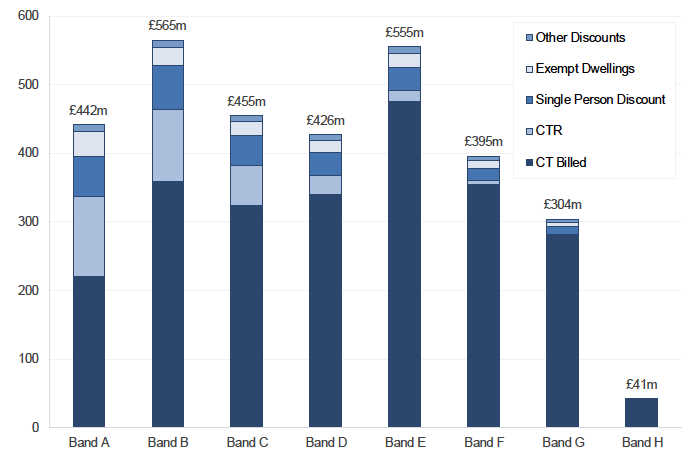
Source: CTaxbase and CTRR
Notes
1 The Council Tax yield if all dwellings paid full rate for their relevant Band and Local Authority
Local authorities collect Council Tax relating to these bills over the year, and also continue to collect late amounts from previous billing years. The provisional in-year Council Tax collection rate for 2018-19 was 96.0 per cent. The total, audited amount of Council Tax collected for Scotland, after CTR and including late payments of bills from prior years was £2.376 billion.
Table 2.8 shows the audited amount of Council Tax collected by each local authority in 2018-19. More information about bills issued in 2018-19 and the provisional amounts collected are available in the ‘Council Tax Collection Statistics, 2018-19’ publication, available at www.gov.scot/publications/council-tax-collection-statistics-2018-19/.
Table 2.8: Council Tax Income after CTR in 2018-19 by Local Authority, £ thousands 1
| Local Authority | Net Council Tax Income |
|---|---|
| Aberdeen City | 116,521 |
| Aberdeenshire | 139,554 |
| Angus | 48,005 |
| Argyll and Bute | 49,868 |
| City of Edinburgh | 259,435 |
| Clackmannanshire | 21,313 |
| Dumfries and Galloway | 63,763 |
| Dundee City | 52,831 |
| East Ayrshire | 48,003 |
| East Dunbartonshire | 60,400 |
| East Lothian | 52,327 |
| East Renfrewshire | 50,114 |
| Falkirk | 63,704 |
| Fife | 156,301 |
| Glasgow City | 220,607 |
| Highland | 120,063 |
| Inverclyde | 28,900 |
| Midlothian | 42,926 |
| Moray | 41,076 |
| Na h-Eileanan Siar | 10,632 |
| North Ayrshire | 53,842 |
| North Lanarkshire | 113,126 |
| Orkney Islands | 8,996 |
| Perth and Kinross | 79,668 |
| Renfrewshire | 75,399 |
| Scottish Borders | 54,984 |
| Shetland Islands | 9,372 |
| South Ayrshire | 54,555 |
| South Lanarkshire | 129,526 |
| Stirling | 47,638 |
| West Dunbartonshire | 33,805 |
| West Lothian | 68,886 |
| Scotland | 2,376,140 |
Source: LFR A0
Notes
1 Figures relate to income collected in financial year 2018-19, which can include amounts that were billed in previous years.
2.3.1.2 Chargeable Dwellings
Table 2.9 shows the number of dwellings in Scotland for each September from 2014-15 to 2018-19. There were a total of 2.615 million dwellings in Scotland in 2018-2019, of which 127,900 were exempt for Council Tax purposes. This gave 2.487 million chargeable dwellings in 2018-2019, an increase of around 2.4 per cent, or 59,300 dwellings, since 2014-15.
Table 2.9: Total Number of Dwellings in Scotland from 2014-15 to 2018-19
| Total Dwellings | Exempt Dwellings | Chargeable Dwellings | |
|---|---|---|---|
| 2014-15 | 2,540,330 | 112,525 | 2,427,805 |
| 2015-16 | 2,557,365 | 116,847 | 2,440,518 |
| 2016-17 | 2,575,495 | 120,089 | 2,455,406 |
| 2017-18 | 2,594,821 | 121,324 | 2,473,497 |
| 2018-19 | 2,614,957 | 127,856 | 2,487,101 |
Source: CTaxbase
Chart 2.8 shows the distribution of chargeable dwellings across Council Tax bands in each local authority. Across Scotland, just under three-quarters of all chargeable dwellings are in Bands A to D. The distribution varies across local authorities due to variations in property market values. Na h-Eileanan Siar has the largest proportion of dwellings in Bands A to D at 89 per cent, whereas East Renfrewshire has the lowest proportion in Bands A to D at 44 per cent.
The ratios for Bands E to H, as shown in Table 2.7, were revised in 2017-18 and so dwellings in these bands, which make up just over a quarter of total dwellings, are subject to higher charges.
The three local authorities with the highest number of chargeable dwellings were Glasgow, Edinburgh and Fife, making up over a quarter of the chargeable dwellings in Scotland between them. Further data on the number of chargeable dwellings by local authority and Council Tax band can be found in the supplementary tables at www.gov.scot/collections/local-government-finance-statistics/#counciltax.
Chart 2.8: Proportion of Chargeable Dwellings at September 2018 by Council Tax Band and Local Authority
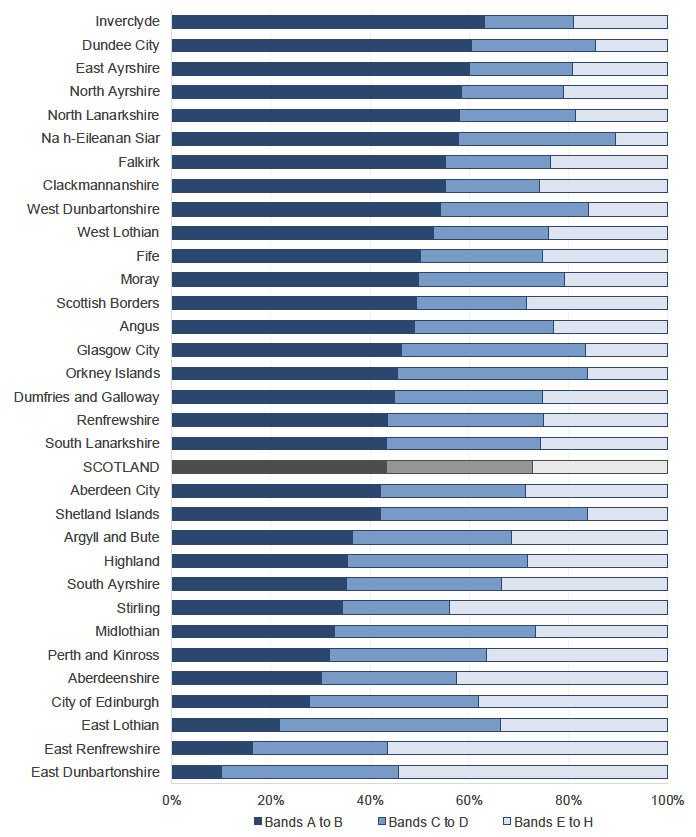
Source: CTaxbase
2.3.1.3 Council Tax Rates and Average Bills
Each local authority determines their own Band D rate of Council Tax as part of their budget setting process. The rate for other bands is then calculated as a set ratio of the Band D rate, see Table 2.7, and so each local authority has different Council Tax rates. The 2018-19 Band D Council Tax rates for each local authority are shown in Chart 2.9. They range from £1,086 in Na h-Eileanan Siar to £1,286 in Glasgow.
Chart 2.9: Band D Council Tax Rate in 2018-19 by Local Authority
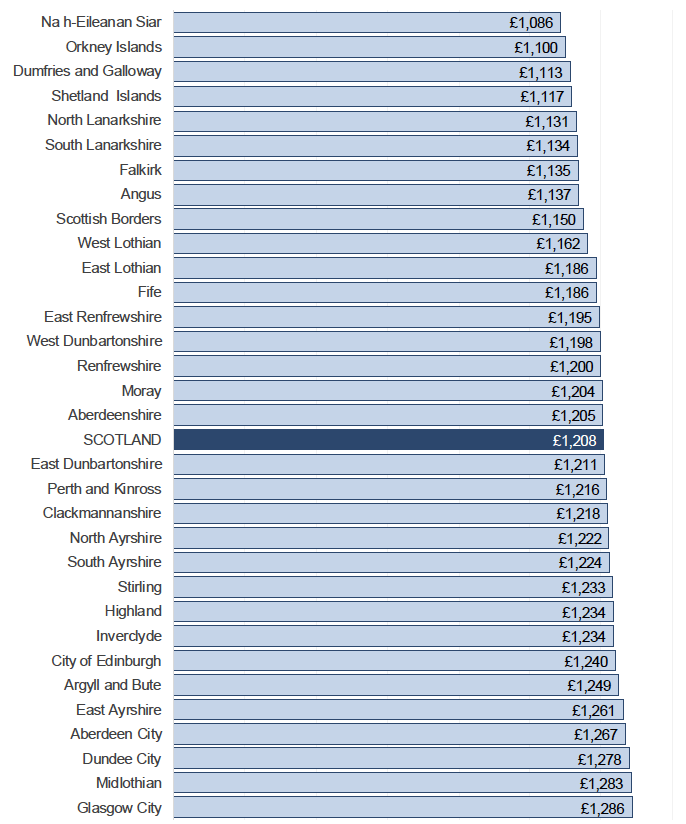
Source: CTAS
From 2007-08 to 2016-7, the Scottish Government and local government worked in partnership to freeze Council Tax rates each year. The one exception is Stirling, who reduced their Band D rate from £1,223 in 2007-08 to £1,209 in 2008-09, and subsequently to £1,197 in 2012-13. The Council Tax freeze caused the Scotland average Band D Council Tax rate to remain steady at £1,149 from 2007-08 to 2016-17 – a fall in real terms.
After nine years of the Council Tax freeze, the Scottish Government secured the agreement of local authorities to cap locally determined Council Tax increases to three per cent in both 2017-18 and 2018-19. In 2018-19, all local authorities increased their Band D Council Tax rate by three per cent.
The average Council Tax bill per dwelling in 2018-19 was £1,106. This differs from the average Band D rate due to the distribution of dwellings across Council Tax bands, as can be seen in Table 2.7 and Chart 2.7, and the application of discounts.
Table 2.10 shows how the average Council Tax bill for Scotland has changed each year from 2014-15.
Table 2.10: Average Council Tax Bill per Dwelling from 2014-15 to 2018-19
| Average Council Tax bill per Dwelling | ||
|---|---|---|
| Before CTR | After CTR | |
| 2014-15 a | £989 | £846 |
| 2015-16 a | £991 | £856 |
| 2016-17 a | £997 | £867 |
| 2017-18 | £1,069 | £936 |
| 2018-19 | £1,106 | £973 |
Source: CTAS, CTaxbase and LFR 12
Notes
a The minor change from year to year is due to a number of factors, such as the distribution of dwellings across bands; discounts and exemptions; new constructions and removal of demolished housing from the roll.
2.3.1.4 Council Tax Reduction (CTR)
Scotland’s Council Tax Reduction (CTR) scheme was introduced in 2013 following the UK Government’s abolition of Council Tax Benefit (CTB), with responsibility for Council Tax reduction schemes given to local government in England and the Scottish and Welsh Governments.
The CTR scheme reduces the Council Tax liability of lower income households in Scotland, and takes into account a household’s earnings, composition and characteristics. The impact of CTR on the average Council Tax bill is also shown in Table 2.10. After taking these reductions in liability into account, the average bill per dwelling for 2018-19 reduced by £133 from £1,106 to £973. These figures are averages and it is important to note that not everyone who pays Council Tax will be eligible for CTR; and that CTR levels will be different depending on individual household circumstances and characteristics.
Scotland’s CTR scheme is funded by the Scottish Government. In 2018-19, CTR funding totalled £351 million. This included additional funding for the 25 per cent increase in the child element in the calculation of the applicable amount within the CTR scheme introduced in April 2017. The extension of the CTR scheme to provide relief for low to middle income households from the impact of the Council Tax reforms on properties in Bands E to H was also introduced at that time.
The amounts distributed to each local authority and the final, audited reduction in liability are shown in Table 2.11. The final, audited reduction in liability due to the CTR scheme was around £331 million across Scotland in 2018-19. This figure is £20.1 million less than the £351 million funding provided by the Scottish Government. The three local authorities with the largest CTR liability are Glasgow, Edinburgh and North Lanarkshire.
Table 2.11: CTR Funding and Final, Audited Liability in 2018-19 by Local Authority, £ thousands
| Local Authority | SG Funding | Final total reduction in liability |
|---|---|---|
| Aberdeen City | 10,304 | 9,839 |
| Aberdeenshire | 8,577 | 7,656 |
| Angus | 5,612 | 5,307 |
| Argyll and Bute | 5,592 | 5,257 |
| City of Edinburgh | 26,672 | 24,676 |
| Clackmannanshire | 3,626 | 3,417 |
| Dumfries and Galloway | 8,953 | 8,491 |
| Dundee City | 12,770 | 11,956 |
| East Ayrshire | 9,455 | 8,779 |
| East Dunbartonshire | 4,619 | 4,383 |
| East Lothian | 5,238 | 4,959 |
| East Renfrewshire | 3,902 | 3,602 |
| Falkirk | 8,491 | 7,890 |
| Fife | 21,352 | 20,704 |
| Glasgow City | 70,692 | 67,380 |
| Highland | 12,916 | 11,933 |
| Inverclyde | 6,605 | 6,383 |
| Midlothian | 5,234 | 4,832 |
| Moray | 3,975 | 3,741 |
| Na h-Eileanan Siar | 1,462 | 1,307 |
| North Ayrshire | 12,059 | 11,268 |
| North Lanarkshire | 23,725 | 22,447 |
| Orkney Islands | 786 | 749 |
| Perth and Kinross | 6,701 | 6,164 |
| Renfrewshire | 13,051 | 12,390 |
| Scottish Borders | 5,584 | 5,140 |
| Shetland Islands | 674 | 651 |
| South Ayrshire | 8,677 | 8,059 |
| South Lanarkshire | 20,370 | 19,471 |
| Stirling | 4,282 | 4,016 |
| West Dunbartonshire | 9,040 | 8,573 |
| West Lothian | 10,004 | 9,451 |
| Scotland | 351,000 | 330,871 |
Source: CTR Extracts and LFR 12
2.3.1.5 Changes to Council Tax Liabilities
Not all dwellings are liable to pay the full rate of Council Tax. Discounts, exemptions and increased rates can be charged for certain types of dwellings, and the CTR scheme is available to support lower income households in meeting their Council Tax liabilities.
Table 2.12 summarises the range of discounts, exemptions and reductions available and the change in liability that applies to each type. Please note that, in some cases, more than one type of discount, exemption or reduction may apply. The examples, given in Table 2.12 are typical but not exhaustive. For a full explanation of Council Tax discounts and exemptions, go to www.gov.scot/policies/local-government/council-tax/.
Table 2.12: Council Tax Discounts, Exemptions, Reductions and Increases
| Type of Support | Typical dwellings that are eligible | Reduction in liability |
|---|---|---|
| Discounts | ||
| Single Person Discount |
Chargeable dwellings in which there is only one resident or only one resident is not disregarded | 25% discount |
| Second Homes | Chargeable dwellings which are no one's sole or main residence, but are furnished and lived in for at least 25 days during any 12 month period. | 10 - 50% discount or discount removed 1 |
| Long Term Empty – 6 to 12 months | Empty properties not meeting the criteria of a second home, or subject to a separate exemption. | 10 - 50% discount 1 |
| Long Term Empty – Less than 12 months | Empty properties not meeting the criteria of a second home, or subject to a separate exemption. | Up to 50% discount or an increase of up to 100% 1 |
| Occupied entirely by disregarded adults | Chargeable dwellings occupied entirely by residents who are disregarded for a discount. | 50% discount |
| Exemptions | ||
| Occupied | Dwellings occupied solely by any combination of students, care leavers, those with a severe mental impairment, school leavers or persons under the age of 18. | 100% reduction |
| Unoccupied | Dwellings which are; empty and unfurnished for less than 6 months or empty and under repair of less than 12 months. Dwellings which are empty because their former residents have moved out for the purposes of receiving personal care by reason of old age, disablement or illness. | 100% reduction |
| Reductions | ||
| Disability reduction | Homes that have been adapted for a disabled person. |
One CT Band 2 or, in the case of Band A properties, 5/9 of the Band D charge. |
| Council Tax Reduction (Passported) |
In receipt of Pension Credit (Guarantee), JSA (income based), ESA (income related) or Income Support. | 100% reduction |
| Council Tax Reduction (Not passported) |
Low income household. | Up to 100% reduction 3 |
Notes
1 The actual change in liability depends on local authority policy. In 2013-14, local authorities gained the discretionary power to remove the empty properties discount or set a Council Tax increase of 100 per cent on properties which have been empty for more than 12 months.
2 For example, a Band D rate property that was eligible for the disability reduction would be charged the Band C rate.
3 The exact change in liability is dependent on a means-test.
Table 2.13 shows the number of dwellings eligible for Council Tax discounts and reductions. Of the 2.49 million chargeable dwellings in Scotland, around one million were eligible for a discount in 2018-19. The most common type of discount was the Single Person Discount, with around two-fifths of chargeable dwellings entitled to the discount in 2018-19. The CTR scheme supports almost half a million dwellings, or around one-fifth of chargeable dwellings, in meeting their Council Tax liability.
Around 64,000 dwellings are classified as second homes or long-term empty properties. Further statistics on these are available at www.gov.scot/publications/housing-statistics-scotland-quarterly-update-published-17-december-2019/.
Table 2.13: Number of Dwellings 1 in Receipt of Council Tax Discounts and Reductions at September from 2014-15 to 2018-19
| Type of Support | 2014-15 | 2015-16 | 2016-17 | 2017-18 | 2018-19 |
|---|---|---|---|---|---|
| All chargeable dwellings | 2,427,805 | 2,440,518 | 2,455,406 | 2,473,497 | 2,487,101 |
| Disability reduction | 13,736 | 13,505 | 13,463 | 13,705 | 13,903 |
| Single Person Discount | 953,612 | 955,505 | 963,297 | 972,537 | 978,504 |
| Second Homes 2 | 27,879 | 27,317 | 26,140 | 22,101 | 24,828* |
| Long Term Empty – Less than 6 months | 31,884 | 36,419 | 36,236 | 37,135 | 39,110 |
| Occupied entirely by disregarded adults |
2,802 | 1,378 | 1,411 | 1,352 | 1,374 |
| Dwellings not subject to discount |
1,411,628 | 1,419,899 | 1,428,322 | 1,440,372 | 1,443,285* |
| Council Tax Reduction recipients | 533,980 | 512,340 | 495,660 | 489,560 | 481,100 |
Source: CTaxbase and CTR Extract
Notes
1 Some dwellings may be eligible for more than one type of support, in these cases the dwelling will be counted under each type of support it is eligible for.
2 It is not possible for some local authorities to separately identify second homes and long-term empty dwellings. For these local authorities, the total number of second homes and long-term empty dwellings has been recorded under Second Homes.
* figure has been revised since previous publications
2.3.2 Non-Domestic Rates (NDR)
Non-Domestic Rates (NDR) are a property tax paid by the owner / occupier or tenant of a non-domestic property. A non-domestic property is an individual property used for non-domestic purposes, such as business premises and third and public sector properties.
The principles of NDR were established in the Lands Valuation (Scotland) Act 1854. This act also provided for the appointment of the Scottish Assessors, who are responsible for determining the classification and valuation of non-domestic and domestic properties, and are independent of both the Scottish Government and local authorities.
As at 1 April 2018, there were over 250,000 non-domestic properties on the Valuation Roll, see Table 2.15, which generated a net income of £2.8 billion, as shown in Table 2.14. This is the total contributable amount [2] of income.
Each local authority reports to the Scottish Government their contributable amount which is included in the annual NDR Account and published as part of the overall Scottish Government’s annual accounts. The amount to be distributed to each authority as part of the annual local government finance settlement is known as the distributable amount and is set by the Scottish Government before the start of the financial year. In 2018-19, the distributable amount was set at £2.6 billion, see Chart 2.6 and Table 2.14. Annex C sets out the calculation of the distributable amount for 2018-19.
Table 2.14: NDR Contributable Income and Distributable Amounts from 2014-15 to 2018-19, £ millions 1
| 2014-15 | 2015-16 | 2016-17 | 2017-18 | 2018-19 | |
|---|---|---|---|---|---|
| NDR Contributable Income 2 | 2,511 | 2,579 | 2,731 | 2,762 | 2,847 |
| NDR Distributable Amount | 2,650 | 2,789 | 2,769 | 2,666 | 2,636 |
Source: NDRI Audited Returns and Local Government Finance Circulars
Notes
1 Local authority level breakdowns of these figures is provided in Table 2.14a in the associated excel file.
2 These are the final, audited income figures, collected by the local authorities. They are net of reliefs paid for by the Scottish Government, but not net of any relief costs covered by local authorities.
From 1 April 2011, the local government funding distribution methodology sees local authorities retain all of the NDR income collected in their area; the previous policy saw NDR redistributed on the basis of population shares. As the combined total of NDR income and GRG provided to local authorities is guaranteed by the Scottish Government, any increase in the amount of NDR collected is compensated for by a corresponding decrease in GRG and vice versa. Any changes from the assumed collection amount in any year is paid out or recovered from local authorities in the calculation of future years’ distributable amount.
The distributable amount is based upon an estimate of the NDR income made prior to the year start, and includes prior year adjustments. It will not therefore match exactly the NDR income received in any year, as shown in Table 2.14, nor the total eventual contributions to the pool for any year.
2.3.2.1 Rateable Values (RVs)
NDR bills are based on the Rateable Value (RV) of a property. The RV is based on a legally defined valuation and broadly corresponds to the notional rental value the property could achieve in the open market if it were vacant and available to let, taking account of the type and nature of the property. As such, it is not necessarily a reflection of the profitability, turnover, or output of the ratepayer.
RVs are generally initially established when a non-domestic property comes into existence. Non-domestic properties and their corresponding RVs are listed on the Valuation Roll, which is maintained by the Scottish Assessors. RVs are periodically updated at non-domestic rate revaluations. Scottish Assessors undertook the last revaluation in 2017, assigning updated RVs to all non-domestic properties in Scotland[3]. Revaluations typically take place on a five year cycle[4].
Table 2.15 shows the composition of properties, and associated RV, on the Valuation Roll by property type. As at 1 April 2018[5], there were 251,695 properties with a total RV of £7.4 billion. Shops and industrial subjects were the most prevalent types of property on the Valuation Roll, each making up 21 per cent of the number of properties, and 22 per cent and 17 per cent of the total RV respectively. Offices are the next largest category in terms of numbers and RV. Together, these three categories account for 60 per cent of properties on the Valuation Roll, and 53 per cent of the total RV.
Table 2.15: NDR Properties at 1 April 2018 by Classification 1
| Category | Number of properties 2 | Rateable Value, £ | % of Properties on Valuation Roll | % of RV on Valuation Roll |
|---|---|---|---|---|
| Advertising | 1,849 | 10,512,920 | 1% | 0% |
| Care Facilities | 2,953 | 120,582,059 | 1% | 2% |
| Communications | 336 | 24,807,975 | 0% | 0% |
| Cultural | 1,435 | 54,971,925 | 1% | 1% |
| Education and Training | 3,704 | 571,503,575 | 1% | 8% |
| Garages and Petrol Stations | 4,236 | 74,813,305 | 2% | 1% |
| Health and Medical | 3,241 | 234,443,755 | 1% | 3% |
| Hotels | 5,647 | 282,710,998 | 2% | 4% |
| Industrial Subjects | 53,238 | 1,263,878,055 | 21% | 17% |
| Leisure, Entertainment, Caravans etc. | 23,246 | 286,755,420 | 9% | 4% |
| Offices | 44,602 | 1,082,284,969 | 18% | 15% |
| Other | 16,583 | 145,521,917 | 7% | 2% |
| Petrochemical | 141 | 122,099,605 | 0% | 2% |
| Public Houses | 3,667 | 132,618,575 | 1% | 2% |
| Public Service Subjects | 9,986 | 359,120,585 | 4% | 5% |
| Quarries, Mines, etc. | 659 | 17,679,149 | 0% | 0% |
| Religious | 6,084 | 56,445,955 | 2% | 1% |
| Shops | 53,742 | 1,620,791,522 | 21% | 22% |
| Sporting Subjects | 15,221 | 37,890,327 | 6% | 1% |
| Statutory Undertaking | 1,125 | 921,358,190 | 0% | 12% |
| All Non-Domestic Properties | 251,695 | 7,420,790,781 | 100% | 100% |
Source: Scottish Assessors Valuation Roll
Notes
1 Figures for 1 April 2019 are provided in Table 2.15a in the associated Excel file.
2 Includes properties with a zero rateable value.
Chart 2.10 provides a breakdown of properties on the Valuation Roll by local authority and RV band: up to £18,000; between £18,000 and £51,000; and above £51,000. These RV bands were significant in 2018-19 as £18,000 was the cut-off for businesses being eligible for the Small Business Bonus Scheme (SBBS), see Chapter 2.3.2.4, and £51,000 was the threshold above which the Large Business Supplement (LBS) was applied, see Chapter 2.3.2.2.
In Scotland, 79 per cent of non-domestic properties had a RV of less than £18,000. Twelve per cent had a RV between £18,000 and £51,000, and nine per cent had a RV higher than £51,000.
Chart 2.10: NDR Properties at 1 April 2018 by Rateable Value Band and Local Authority
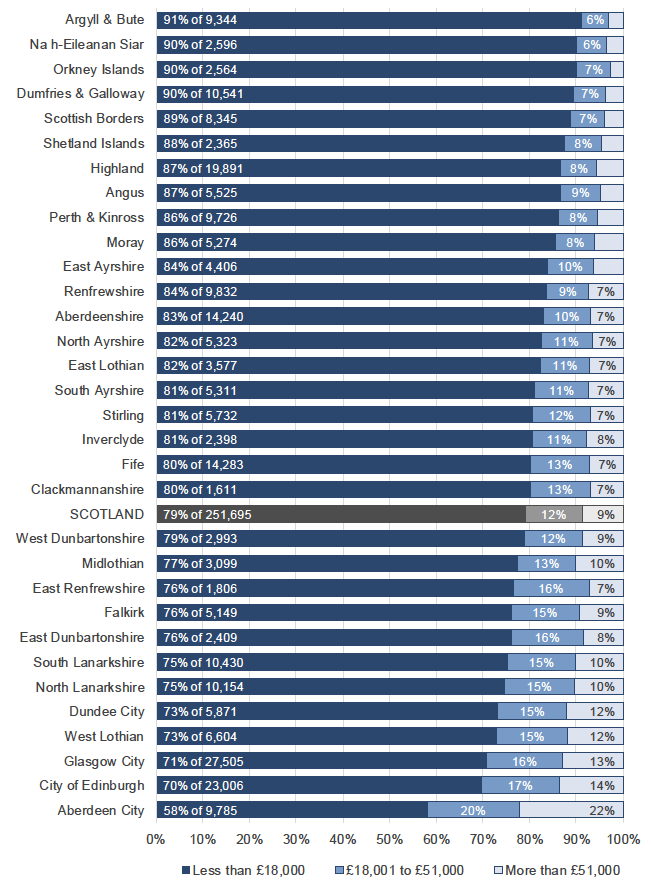
Source: Scottish Assessors Valuation Roll
Notes
1 Includes properties with a zero rateable value.
2 Figures at 1 April 2019 are provided in the Chart 2.10a tab of the associated Excel file.
3 Some percentages are not displayed for presentational purposes. Percentages for all bands by local authority are available in the ‘Chart 2.10’ tab of the associated Excel file.
In Argyll & Bute, 91 per cent of properties have a RV of less than £18,000, compared to 58 per cent of properties in Aberdeen City. Conversely, Aberdeen City has the highest proportion of properties with a RV of more than £51,000, at 22 per cent, while this figure is lowest in Argyll and Bute and Orkney at three per cent.
2.3.2.2 NDR Bills
NDR bills are calculated using the RV of the property, multiplied by a poundage set nationally by Scottish Ministers, less any relief or exemption entitlement.
(NDR Bill) Property = (RV) Property x (Poundage) National – (Reliefs) Property
In 2018-19 the Large Business Supplement (LBS) was applied to properties with an RV greater than £51,000 (the LBS threshold), in addition to the poundage; effectively increasing the poundage on these properties. The LBS was 2.6p in 2018-19 [6].
As NDR bills in Scotland are directly related to the RV of individual non-domestic properties, changes in the total RV occurring within a revaluation cycle, i.e. between revaluation years, impact on the amount of NDR available for collection, as shown in Table 2.16.
Since the last revaluation in 2017, the total RV has increased from £7.36 billion at 1 April 2017 to £7.44 billion at 1 April 2019. Table 2.16 also shows that before the 2017 revaluation, the total RV had increased from £6.7 billion in April 2014 to £6.8 billion in April 2016. This was due to the net impact of several factors, including increases in the tax base from new properties or extensions of existing properties; and decreases as demolished properties are deleted from the Valuation Roll or as the RV is reduced as a result of appeals[7].
Inflation, however, is a key driver of growth in NDR income as changes in the poundage rate, set nationally by Scottish Ministers[8], have previously typically been tied to the Retail Price Index (RPI)[9], other than in the first year of a revaluation.
At a revaluation, the poundage is reset by the Scottish Government, bearing in mind the resulting total RV change and the amount of revaluation appeals anticipated over the forthcoming cycle. In England, revenue-neutral revaluations are a statutory requirement, with the poundage generally decreasing in line with average RV increases, or vice versa. This is not the case in Scotland, with the 2017 revaluation and poundage actually leading to a decrease in anticipated revenue over the following cycle.
Table 2.16 shows the RV increase from £6.8 billion to £7.4 billion between April 2016 and April 2017 – mainly as a result of revaluation, with a corresponding decrease in the poundage from 48.4p to 46.6p.
Exempt properties, which do not pay rates, and relief schemes, such as the SBBS, can significantly reduce the amount paid in NDR bills, and therefore the NDR income, see Chapter 2.3.2.4.
Table 2.16: NDR Income, Total RV and Poundage Rate from 2014-15 to 2018-19
| 2014-15 | 2015-16 | 2016-17 | 2017-18 a | 2018-19 | |
|---|---|---|---|---|---|
| NDR Income, £ millions 2 | 2,511 | 2,579 | 2,731 | 2,762 | 2,847 |
| Total RV, £ millions 3 | 6,681 | 6,719 | 6,796 | 7,358 | 7,439 |
| Poundage Rate, pence | 47.1 | 48.0 | 48.4 | 46.6 | 48.0 |
| LBS, pence 4 | 1.1 | 1.3 | 2.6 | 2.6 | 2.6 |
| LBS Threshold, £ 4 | 35,000 | 35,000 | 35,000 | 51,000 | 51,000 |
Source: NDRI Audited Returns and Scottish Assessors Valuation Roll
Notes
1 A revaluation occurred in 2017.
2 Income figures are contributable income and, as such, they are net of reliefs awarded by the Scottish Government, but gross of any local reliefs, or top-ups to discretionary reliefs that the local authorities award themselves.
3 As at the start of each financial year.
4 The LBS is applied in addition to the poundage for properties with a high RV.
2.3.2.3 Rates Retention Schemes
There are currently two policy initiatives that directly link to the amount of NDR collected: the Business Rate Incentivisation Scheme (BRIS) and Tax Incremental Financing (TIF).
BRIS was introduced from April 2012 to incentivise local authorities to maximise existing NDR income and attract new economic growth. BRIS allows all local authorities that exceed their annual NDR buoyancy target, the target percentage increase in their tax base, to benefit from receiving additional grant, equal to 50 per cent of any additional NDR income. In effect, this means that only 50 per cent of the additional NDR attributable to the increased buoyancy is deducted from the GRG.
This increased funding is carried forward between revaluation years, with each year’s increased funding being carried forward to the next year and added to any new retention awarded, assuming the previous year’s income is maintained. In 2018-19, the amount of additional funding received under this scheme[10] was £8.8 million.
The Scottish Government is also piloting TIF which allows local authorities to fund public sector infrastructure, which unlocks private sector investment, contributing to sustainable and inclusive economic growth. This growth is funded from future incremental NDR income that will be generated as a result of attracting more businesses into the area because of the upfront public sector enabling investment.
TIF is currently being piloted through secondary legislation under existing provisions of the Local Government Finance Act (1992) in four local authorities: Argyll & Bute, Falkirk, Fife and Glasgow. Of these four pilots, only Argyll & Bute and Falkirk reported TIF income in 2018-19. They retained a total of £1.7 million NDR income in 2018-19, compared to £1.5 million in 2017-18.
2.3.2.4 NDR Reliefs
There are a number of types of NDR relief that reduce the NDR bill for qualifying properties[11]. Table 2.17 shows the amount of relief provided for the main types of relief available for each year between 2014-15 to 2018-19. Local reliefs and the elements of discretionary reliefs funded by local authorities are not included.
Table 2.17: Amount of NDR Relief Provided from 2014-15 to 2018-19 by Relief Type, £ thousands 1, 2
| 2014-15 | 2015-16 | 2016-17 | 2017-18 | 2018-19 | |
|---|---|---|---|---|---|
| Empty Property Relief | 140,962 | 141,604 | 93,682 | 93,988 | 90,937 |
| Charity Relief | 181,242 | 189,312 | 201,215 | 214,418 | 218,977 |
| Sports Club Relief | 13,487 | 13,852 | 13,851 | 13,620 | 15,739 |
| Disabled Rates Relief | 59,648 | 60,599 | 61,498 | 61,511 | 64,354 |
| SBBS | 170,635 | 179,544 | 187,029 | 240,663 | 261,684 |
| Religious Exemptions | 26,113 | 26,625 | 27,014 | 26,303 | 27,129 |
| Rural Relief | 4,244 | 4,235 | 4,114 | 3,988 | 3,946 |
| Renewable Energy Relief | 9,280 | 9,545 | 647 | 1,279 | 7,399 |
| New Start Relief | 484 | 188 | 398 | 497 | 447 |
| Fresh Start Relief | 536 | 573 | 607 | 436 | 1,690 |
| Transitional Relief | 26,330 | 11,899 | |||
| Day Nursery Relief 3 | 9,604 | ||||
| BGA - Unoccupied New Build 3 | 5,660 | ||||
| BGA - New Occupied & Improved 3 | 11,207 | ||||
| Other 4 | 221 | 422 | 730 | 1,104 | 1,161 |
| Gross Amount | 606,852 | 626,497 | 590,784 | 684,137 | 731,835 |
Source: NDRI Audited Returns
Notes
1 Figures include mandatory and discretionary elements of relief where applicable, but exclude backdated payments of relief and local authorities’ own contributions to reliefs.
2 A breakdown of NDR reliefs provided in 2018-19 by local authority is provided in Table 2.17a in the associated Excel file.
3 Day Nursery and Business Growth Accelerator (BGA) Reliefs were introduced in 2018.
4 Other includes Hardship Relief, Enterprise Areas and District Heating Relief, and from 2018-19 also includes Mobile Mast Relief.
The gross amount of relief provided has increased substantially from £607 million in 2014-15 to £732 million in 2018-19. Key reasons for this increase in total relief costs include:
- changes to the poundage;
- changes to the tax base due to recent growth in overall RV and increase in overall RV at revaluation;
- changes in relief entitlement;
- an increased awareness of relief schemes; and
- the introduction of new reliefs.
For example, the SBBS has been expanded in recent years and awareness of the scheme has increased, both of which will have contributed to the rise in cost of SBBS.
Following the 2017 revaluation, a transitional relief scheme was introduced for pubs, hotels and restaurants with a RV below £1.5 million, and for offices in Aberdeen City and Aberdeenshire. A relief for day nurseries and the Business Growth Accelerator relief for new and improved property were both introduced in 2018.
Chart 2.11 shows the values of reliefs awarded during 2018-19. The SBBS and Charity relief, including the mandatory relief and the part of the discretionary relief which is funded by the Scottish Government, together accounted for £481 million, or around two thirds of the total amount of reliefs awarded.
Chart 2.11: Value of NDR Reliefs in 2018-19
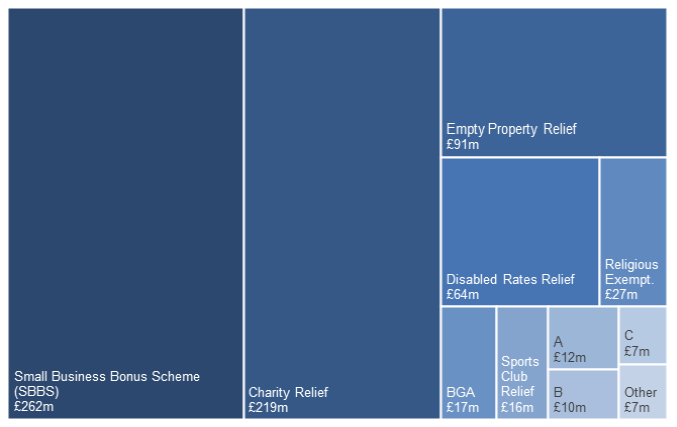
Source: NDRI Audited Returns
Notes
A = Transitional Relief; B = Day Nursery Relief; C = Renewable Energy Relief
2.4 Surplus / Deficit to be met from Reserves
A surplus (-) occurs when a local authorities revenue expenditure is lower than the amount of service income and general funding available to them. A surplus is added to a local authorities’ reserves and carried forward to the next year.
A deficit (+) occurs when a local authorities revenue expenditure is higher than the amount of service income and general funding available to them. Any deficit must be met from a local authorities’ reserves.
The HRA reserve is not permitted to show a deficit at the end of the financial year and if this occurs, local authorities are required to transfer funds from the General Fund to cover this deficit.
Table 2.18 sets out the movement in the General Fund and HRA reserves in 2018-19. Local authorities held £1,638 million between their General Fund and HRA reserves at 1 April 2018.
In 2018-19 local authorities’ revenue expenditure exceeded its income and this resulted in a deficit of £53 million across the General Fund and HRA. Local authorities transferred £48 million into the General Fund and HRA from other reserves held by the authority.
This meant that, overall, the General Fund and HRA decreased by £4 million in 2018-19, giving a reserve balance of £1,634 million at 31 March 2019 between the General Fund and HRA.
More information on local authorities’ reserves is provided in Chapter 4.1.
Table 2.18: Movement in General Fund and HRA Reserves in 2018-19, £ millions
| General Fund 1 | Housing Revenue Account | Total | |
|---|---|---|---|
| Balance as at 1 April 2018 a | -1,461 | -177 | -1,638 |
| Add: Surplus (-) or Deficit (+) for 2018-19 | 33 | 19 | 53 |
| Add: Movements between Reserves 2 | -29 | -19 | -48 |
| Balance as at 31 March 2019 | -1,457 | -177 | -1,634 |
Source: LFR 23
Notes
1 Amounts relating to Harbour Accounts for Orkney and Shetland are included in the General Fund column of this table.
a This excludes amounts relating to unrealised gains that have been included in the General Fund or HRA under IFRS 9.
2 Net movements in are shown as a negative; net movements out are shown as a positive.
Contact
Email: lgfstats@gov.scot
There is a problem
Thanks for your feedback